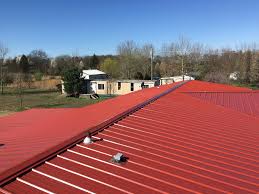PROS
Metal beats out conventional roofing materials in several ways:
Expected life.
Properly installed, a metal roof should last as long as the house,
sealing out water, surviving high winds, and easily shedding snow. Metal
is resistant to fire, mildew, insects, and rot.
Warranties
vary widely, but most companies back their products for 20 to 50 years.
Paint finishes typically have a 30-year limited warranty.
Weight.
Compared to the weight of tile at 750 pounds per square (an area equal
to 100 square feet) or concrete tile at 900 pounds per square, metal
roofing is very lightweight. Most varieties run from 50 to 150 pounds
per square.
Because of the material’s light weight, you can save on engineering
and building the supporting structure. In fact, if you’re building a
house or an addition, you can often downsize or reduce the number of
roof support members.
Some
types of metal roofing materials may be applied over an existing roof
without the need for tear-off or additional structural support.
Speed & ease of roofing installation. Most metal roofing materials come in multiple-shingle sections or in 12- to 36-inch-wide panels.
An
accomplished contractor can install these quickly. If your roof is
stripped off and a storm is on the way, shortening the process by a day
or two may offer a critical advantage. Obviously, there is also
considerable labor savings if you can ease and shorten the duration of
roof installation.
Fire resistance.
Because metal roof materials are noncombustible, they typically have a
Class A fire rating (the most fire-resistant rating). Just be aware that
part of a roof’s overall classification depends on materials beneath
the surface that could ignite in intense heat, too. Most metal roofs
applied over a combustible material such as wood shingles have a lower,
Class C rating for this reason. See notes under “Metal Roofing
Drawbacks” regarding problems in the event of a house fire.
Heat conduction.
Metal reflects radiant heat from the sun, minimizing midday heat gain.
This means you save energy needed for air conditioning during the day.
Though the material itself is low in insulation R-value, metal roofing
can be applied over rigid-foam insulation that has very high R-values.
In addition, many systems utilize a dead-air space between the metal and
roof deck to increase energy efficiency.
Minimal roof pitch.
Most metal roofing materials can be installed on gently pitched roofs
without leaking. Minimum roof pitch typically is 3-in-12 (the roof rises
3 inches for each horizontal foot).Maximum shedding of rain and snow.
Metal roofing is practically impervious to rain and snow because of the
way the panels interlock and because the surfaces are hard and
slippery. In addition, dark tones of metal roofing quickly warm in the
snow, encouraging snow melt.

